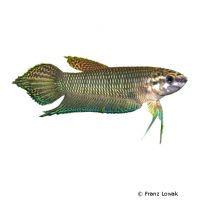Sim's Betta (Betta simorum)
| Sim's Betta Betta simorum | |
|---|---|
| Name | Sim's Betta |
| Name Lat. | Betta simorum |
| Family | Gouramies |
| Family lat. | Osphronemidae |
| Order | Labyrinth Fishes |
| Order lat. | Anabantiformes |
| Origin | Indonesia |
| Habitat | Streams, ponds |
| Diet | Carnivore |
| pH | 5.0-6.5 |
| Behavior | ♂ territorial |
| Keeping | Pair, harem |
| Care Level | Moderate |
| Reproduction | Bubble nest builder |
| Breeding | Moderately difficult |
| Life Span | 2-5 years |
| Protection | No |
| Metric Units | |
| Size | 10 cm |
| Temperature | 22-27 °C |
| Hardness | 2-10 °dH |
| Aquarium | 100 l |
| US Units | |
| Size | 3.9" |
| Temperature | 72-81 °F |
| Hardness | 36-178 ppm |
| Aquarium | 25 gal |
Distribution and habitat
The Great Simor Fightfish originate from the Indragiri River catchment area in Jambi Province on the island of Sumatra (Indonesia). There they live in small, shallow and weedy, low-oxygen streams, ponds and pools as well as in peat swamps.
Maintenance
The aquarium should have dense planting, with many hiding places (stones, roots). A dark substrate with peat and foliage (sea almond leaves) and subdued light (floating plant cover) is ideal. They only need a shallow water depth, 25 cm is sufficient.
No ammonia, ammonium and nitrite should be detectable, the nitrate value should not exceed 100 mg/l. To ensure the water quality and oxygen content, a filter and heater adapted to the aquarium size is required, as well as lighting for the species-appropriate day-night rhythm of the animals.
Diet
In the wild they feed on insect larvae and small invertebrates. The food supply consists of live, frozen and dry food. For a balanced diet, feed once a day with a high-quality dry food (flakes, granules, pellets) as well as cyclops, daphnia, artemia, mysis and mosquito larvae (live or frozen)
Only feed as much as will be eaten within a few minutes. Regular and varied feeding promotes health and increases resistance.
Behaviour and compatibility
They should be kept in pairs or in a harem, one male with several females. Males are relatively peaceful, but defend their territory. Keeping multiple harems is only recommended in a large, richly structured tank. They can be kept in a community tank with not too small fish and many hiding places. Other fish of similar shape and coloration are usually perceived as enemies.
Basically, only mutually compatible fish species with similar demands on water condition and water temperature may be socialized.
Sex dimorphism
The male is more colorful and has a long extended dorsal and anal fin.
Reproduction and breeding
They belong to the foam nest building fighting fish. The foam nest is built by the male, which also takes care of the brood. The eggs ejected during the numerous matings (entwinements) are collected by the male and introduced into the nest. The larvae hatch after about 24 hours and swim freely after 2-6 days.
The fry must be fed several times a day with special rearing food (dust food, Artemia nauplii). In a community tank breeding is hardly possible, because the spawn is easy prey.
Important
They have an additional respiratory organ, the so-called labyrinth (suprabranchial organ) with which they breathe atmospheric air and can suffocate if this is not possible. The air temperature in the breathing zone must not be lower than the water temperature!
The foliage (sea almond tree, oak, etc.) enriches the water with humic substances, naturally lowers the pH and when rotting promotes the development of microorganisms, which are a valuable secondary food source.
The well-being of the fish should be monitored regularly. Temperature should be checked daily, pH, hardness and nitrate levels at least every 14 days. Regular partial water changes are recommended, even when contaminant levels have not yet reached the upper limit. Sudden changes in water quality should be avoided. Newly introduced fish must be accustomed slowly to the water in the aquarium.
Further literature can be found in your pet store.
References
Text: petdata; Image: Franz Lowak
Source: BMELV (1998): Tierschutzgutachten - Haltung von Zierfischen (Süßwasser); RIEHL & BAENSCH (2006): Aquarien Atlas Bd. 1, Mergus Verlag; ENGELMANN (2005): Zootierhaltung - Tiere in menschlicher Obhut: Fische, Verlag Harri Deutsch
- Gemäß § 21 Abs. 5 Tierschutzgesetz idgF
